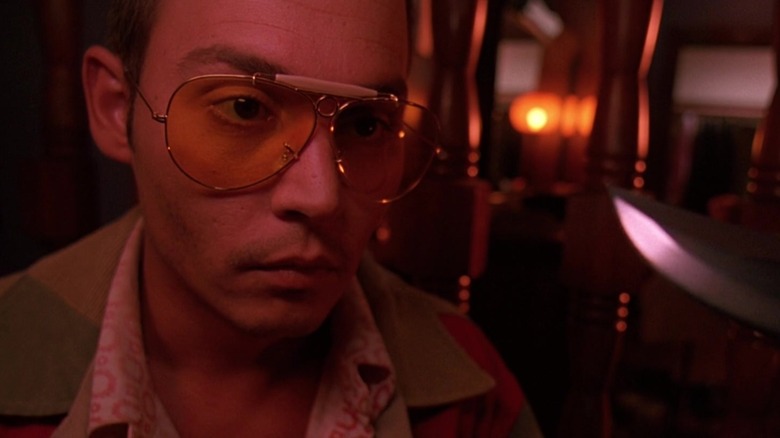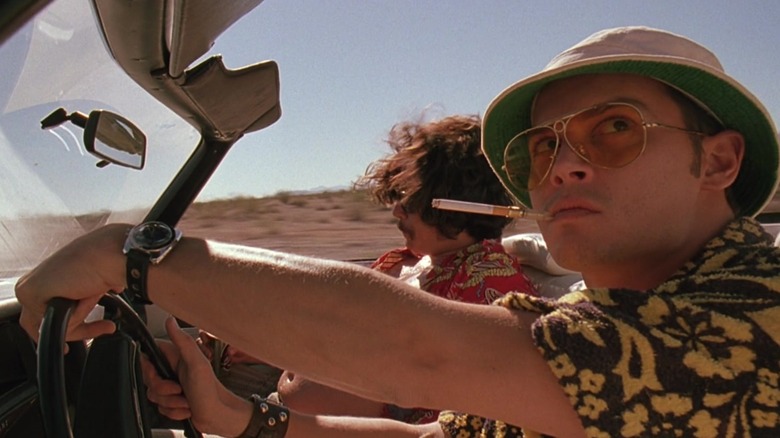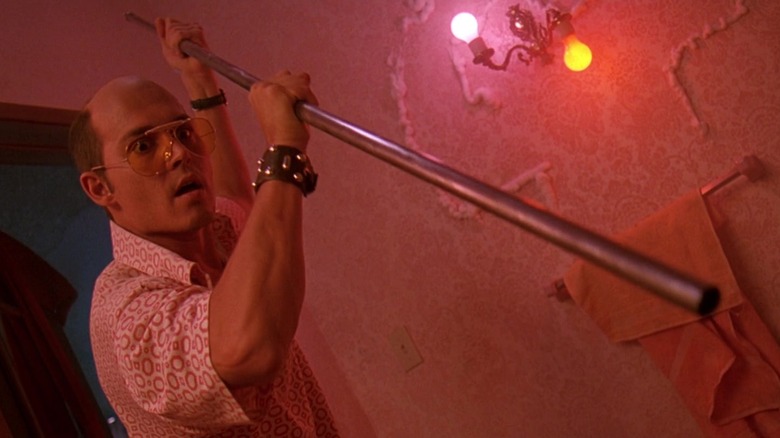The Writing Credits On Fear And Loathing In Las Vegas Secretly Tell One Chaotic Story
We may receive a commission on purchases made from links.
A film adaptation of Hunter S. Thompson's zonked-out, gonzo 1971 autobiography "Fear and Loathing in Las Vegas" began in earnest as long ago as 1976. The story goes that Larry McMurtry ("Lonesome Dove," "Hud," "The Last Picture Show") signed on to adapt Thompson's unadaptable novel into a screenplay, but that the project fell apart. Several notable filmmakers each flirted with the idea of making a "Fear and Loathing" movie, including Martin Scorsese, Oliver Stone, and even famed animator Ralph Bakshi (whose "Fear and Loathing" would have, no doubt, been spectacular).
The film didn't make it to the big screen until 1998, when audiences were treated to an ultra-chaotic version directed by Terry Gilliam. Production on the 1998 version started six years earlier, in 1992, when Rhino Films (!) sought to produce a version directed by Lee Tamahori. Tamahori couldn't do it, however, as he was busy shooting either the lugubrious noir "Mulholland Falls" or the survivalist thriller "The Edge." Johnny Depp, an executive producer on the film, was already locked in to play the Hunter Thompson analogue, Raoul Duke, and he was eager to see the project gel. He suggested that Bruce Robinson ("Withnail & I") direct, but Robinson had no interest. Years were passing in production hell, and Rhino was about to lose the filming rights to Thompson's book, so they hastily approached Alex Cox ("Repo Man," "Sid and Nancy") to write the screenplay and direct. Luckily, Cox was available, and he started on the project within a few months.
We'll get to the actual production on "Fear and Loathing" in a moment, but we do have to pause and describe the headbutting that Cox had with the studio before the subsequent hiring of Terry Gilliam in his place. Thanks to a lot of bad blood, chaotic development, and general confusion, four writers are credited on "Fear and Loathing in Las Vegas," even though the script was only penned by two of them. The making of "Loathing" is almost as chaotic as the film itself.
Alex Cox lays out an ultimatum that doesn't go well
The story of the chaos behind the "Fear and Loathing" movie was detailed in a 1998 article in Premiere Magazine, so audiences knew about how wild it was, even at the time. Gilliam also published his version of the "Fear and Loathing" script (which he wrote with Tony Grisoni) in 2000, and in his foreward, explained the horrid mix-up between his version and the version that Cox had been hired to write.
The story goes that Alex Cox dove into adapting Thompson's book, bringing in another writer, Tod Davies, to serve as co-author. It seems, though, that Cox immediately began arguing with one of Rhino's producers, a woman named Laila Nabulsi, over creative issues. Cox tried to go over Nabulsi's head, forcing the higher-ups at Rhino to choose to keep him or Nabulsi on the project. Rhino immediately fired Cox over the ultimatum. Thanks to a stipulation in his contract, however, Cox still got $60,000.
It also turns out that Nabulsi wasn't the only one who didn't like Cox's script. Evidently, Thompson hated it as well. The Cox/Davies script can be found easily enough online.
Somewhere in this mess, Terry Gilliam was hired to direct, and Universal stepped in to distribute the movie, so the project was moving forward. When Cox was fired, however, the studio had to rush to find a new script. Gilliam and Grisoni rushed a draft in 10 days. The studio decided to go with the Gilliam/Grisoni script, and shooting finally began in the summer of 1997. There wasn't a final budget yet, but shooting was starting anyway. It was a notoriously chaotic shoot, marked by occasional mundanity. And, to add to the chaos (as Gilliam said in his published foreword), there was some debate as to whether or not he was using the correct script. Was he supposed to be using the Cox script that was thrown out?
This is where a debate with the WGA began.
The WGA dictated who gets credited
It seems that the Writers Guild of America had a stipulation in place that a screenwriter has to be credited if they contributed more than 40% of the material used in filming. The Cox/Davies script had been thrown out, of course, and technically, 0% of it was used, but an issue arose over the adaptation. Both Gilliam/Grisoni and Cox/Davies quote heavily from Thompson's original work, and even envisioned certain scenes exactly the same. The WGA dispute was discussed in a 1998 New York Times article wherein Gilliam was given a test. He had to prove that more than 60% of the script was his before Cox's name would be taken off the film. Of course, when multiple screenwriters adapt the same book, there are bound to be similarities, meaning Gilliam couldn't claim to have written the majority of his own script.
It looked for a moment, then, that Cox/Davies were to be the sole credited screenwriters for "Fear and Loathing," despite Gilliam claiming that he was not using their material at all. Gilliam once joked (on the "Fear and Loathing" DVD commentary track) that he wanted to add an introduction to the movie, saying that no screenwriters worked on it at all. Eventually, the WGA came around ... on both sides. Gilliam/Grisoni were allowed to be credited first, and Cox/Davies second. Gilliam hated having to share credit.
And how does Cox feel about all this? Quite badly. Cox actually tried to take Gilliam to court on the matter, saying that Gilliam ripped off parts of his screenplay. He bristled at the idea that he and Gilliam were "merely adapting the same material." Cox felt that Gilliam was simply reusing a lot of his writing and claiming it as his own. Cox finally got credit and a hefty paycheck. Gilliam got to make one of the most headache-inducing movies of all time. Hunter Thompson was in it. Perhaps we all win. Perhaps.


